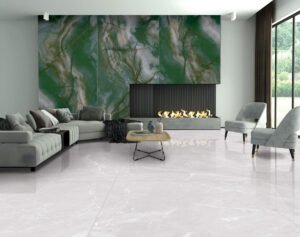Living room Floor Tiles are the heart of any home, serving as a gathering place for family and friends. Choosing the right flooring is crucial not only for aesthetic appeal but also for functionality and maintenance. Living room floor tiles have gained popularity for their durability, variety, and easy maintenance. In this comprehensive guide, we’ll explore the various types of living room floor tiles, their benefits, tips for selection, installation guidance, maintenance practices, and current trends in the market.
Why Choose Floor Tiles for Your Living Room?
1. Durability
One of the most significant advantages of floor tiles is their durability. Made from materials like ceramic, porcelain, and natural stone, tiles can withstand heavy foot traffic, making them ideal for living rooms where people gather frequently. Unlike carpet, which can wear out over time, tiles maintain their appearance and performance for years.
2. Easy Maintenance
Floor tiles are incredibly easy to clean. A quick sweep or vacuum followed by mopping with a mild cleaner can keep your tiles looking fresh and new. Unlike wood or carpet, tiles are resistant to stains, spills, and allergens, making them a practical choice for families and pet owners.
3. Variety of Styles
With countless designs, colors, and textures available, floor tiles can suit any interior design style, from contemporary to traditional. Whether you prefer the sleek look of polished porcelain or the rustic charm of textured stone, tiles can help you achieve your desired aesthetic.
4. Temperature Regulation
Tiles are naturally cool, making them a comfortable choice for warmer climates. They can also help regulate indoor temperatures, providing a comfortable environment year-round. In colder climates, pairing tiles with underfloor heating can create a cozy atmosphere without sacrificing style.
5. Eco-Friendly Options
Many tile manufacturers are now producing eco-friendly options made from recycled materials or sustainable sources. Choosing these products can reduce your environmental footprint while still achieving a beautiful living space.
Popular Types of Living Room Floor Tiles
When selecting floor tiles for your living room, understanding the different types available can help you make an informed decision. Here are some of the most popular options:
1. Ceramic Tiles
Ceramic tiles are made from clay and baked at high temperatures, making them both durable and versatile.
- Benefits:
- Variety: Available in numerous colors, patterns, and finishes.
- Cost-Effective: Generally more affordable than other types of flooring.
- Easy to Install: Suitable for DIY projects.
Competitor Insight: Orientbell emphasizes the versatility and affordability of ceramic tiles, making them a popular choice among homeowners.
2. Porcelain Tiles
Porcelain tiles are a subtype of ceramic, made from denser clay and fired at higher temperatures. They are often more durable and moisture-resistant than standard ceramic tiles.
- Benefits:
- High Durability: Excellent for high-traffic areas.
- Water Resistant: Suitable for areas prone to moisture, such as near doors or windows.
- Aesthetic Variety: Can mimic natural materials like wood and stone.
3. Natural Stone Tiles
Natural stone tiles, including marble, granite, and slate, add a touch of luxury to any living room floor tiles. Each piece is unique, with natural variations in color and texture.
- Benefits:
- Timeless Elegance: Offers a sophisticated and upscale look.
- Durability: Extremely strong and long-lasting.
- Variety: Available in a range of colors and textures.
4. Vinyl Tiles
Vinyl tiles provide a budget-friendly alternative that can mimic the appearance of more expensive materials like wood or stone.
- Benefits:
- Comfort: Softer and warmer underfoot than ceramic or stone.
- Easy Installation: Often features a peel-and-stick design for simple DIY projects.
- Wide Variety: Available in various styles and patterns.
5. Cement Tiles
Cement tiles, known for their vibrant colors and intricate patterns, are becoming increasingly popular in modern homes.
- Benefits:
- Artistic Appeal: Can create stunning feature floors.
- Durability: Strong and resistant to wear.
- Customization: Can be custom-designed for a unique look.
Benefits of Using Tiles in Your Living Room
1. Aesthetic Versatility
Tiles offer endless design possibilities. You can choose from sleek, contemporary designs to rustic, vintage looks. They can be used to create a cohesive theme or to make a bold statement.
2. Comfort and Warmth
While tiles are cool underfoot, combining them with area rugs can create a warm and inviting atmosphere. Additionally, underfloor heating can make tiled floors cozy during colder months.
3. Allergy-Friendly
Tiles do not trap dust, allergens, or pet dander like carpets do, making them a healthier choice for those with allergies or respiratory issues.
4. Increased Home Value
Quality tiles can enhance the resale value of your home. Potential buyers often view tiled floors as a premium feature that adds value to a property.
Choosing the Right Living Room Floor Tiles
Selecting the perfect floor tiles for your living room involves several considerations. Here are some tips to guide your decision-making process:
1. Assess Your Lifestyle
Consider your lifestyle and how you use your living room. If you have pets or children, opt for durable and easy-to-clean options like porcelain or ceramic tiles.
2. Evaluate Design Style
Identify your design style and choose tiles that complement it. For a modern look, consider sleek, large-format tiles. For a more traditional space, natural stone or patterned tiles might be a better fit.
3. Consider Color and Texture
Color and texture can significantly impact the overall feel of the room. Light colors can make a space feel larger and more open, while darker tones can create a cozy, intimate atmosphere.
4. Think About Layout
Plan your tile layout before installation. You can opt for a classic straight lay, a diagonal pattern for added interest, or even a herringbone design for a modern touch.
5. Budget
Set a budget before shopping for tiles. Consider not only the cost of the tiles themselves but also any installation costs, underlayment, and maintenance.
Installation Tips for Living Room Floor Tiles
Proper installation is crucial for ensuring your tiles last and perform well. Here are some essential tips:
1. Prepare the Subfloor
Make sure the subfloor is clean, dry, and level. Any imperfections can lead to tile cracking or uneven surfaces.
2. Acclimate Your Tiles
Allow your tiles to acclimate to the room temperature and humidity before installation to prevent warping or cracking.
3. Use the Right Adhesive
Choose an adhesive compatible with your tile type. Follow the manufacturer’s instructions for best results.
4. Plan Your Layout
Lay out your tiles without adhesive to determine the best arrangement. This helps minimize cuts and ensures a balanced look.
5. Grout Carefully
After the tiles are set, apply grout to the joints. Use a grout float and ensure all joints are filled, wiping away excess grout promptly.
Maintenance of Living Room Floor Tiles
To keep your living room floor tiles looking their best, follow these maintenance tips:
1. Regular Cleaning
Sweep or vacuum regularly to remove dirt and debris. Mop with a mild cleaning solution to keep tiles shiny and fresh.
2. Avoid Harsh Chemicals
Avoid using abrasive cleaners or harsh chemicals that can damage the finish of your tiles. Stick to pH-balanced cleaning solutions.
3. Inspect Grout Lines
Periodically check grout lines for cracks or damage. Reapply grout as needed to prevent moisture intrusion.
4. Seal Natural Stone Tiles
Natural stone tiles often require sealing to protect them from stains and moisture. Follow the manufacturer’s guidelines for sealing frequency.
Current Trends in Living Room Floor Tiles
Staying informed about current trends can help you choose tiles that feel fresh and modern. Here are some notable trends in living room floor tiles:
1. Large Format Tiles
Large format tiles create a seamless look with fewer grout lines, making spaces feel larger and more open. They are particularly popular in contemporary designs.
2. Textured Finishes
Textured tiles, such as matte or rough surfaces, add depth and interest to floors. They can enhance the tactile experience and make the space feel more inviting.
3. Mix and Match Styles
Combining different tile types, colors, and sizes is gaining popularity. This eclectic approach allows homeowners to express their unique style.
4. Sustainable Materials
Eco-friendly tiles made from recycled materials or sustainable sources are becoming increasingly sought after. They provide a responsible choice for environmentally-conscious consumers.
5. Natural Looks
Tiles that mimic the appearance of natural materials, such as wood or stone, are in high demand. They offer the beauty of nature while providing the durability of tile.
Conclusion
Living room floor tiles are an excellent choice for homeowners looking to combine style, durability, and ease of maintenance. With a variety of options available, including ceramic, porcelain, natural stone, vinyl, and cement tiles, you can create a beautiful and functional living space.
By considering your lifestyle, design preferences, and current trends, you can confidently choose floor tiles that enhance your living room. Whether you opt for the classic elegance of natural stone or the modern appeal of large-format porcelain tiles, the right flooring can transform your living space into a stylish and welcoming environment.




